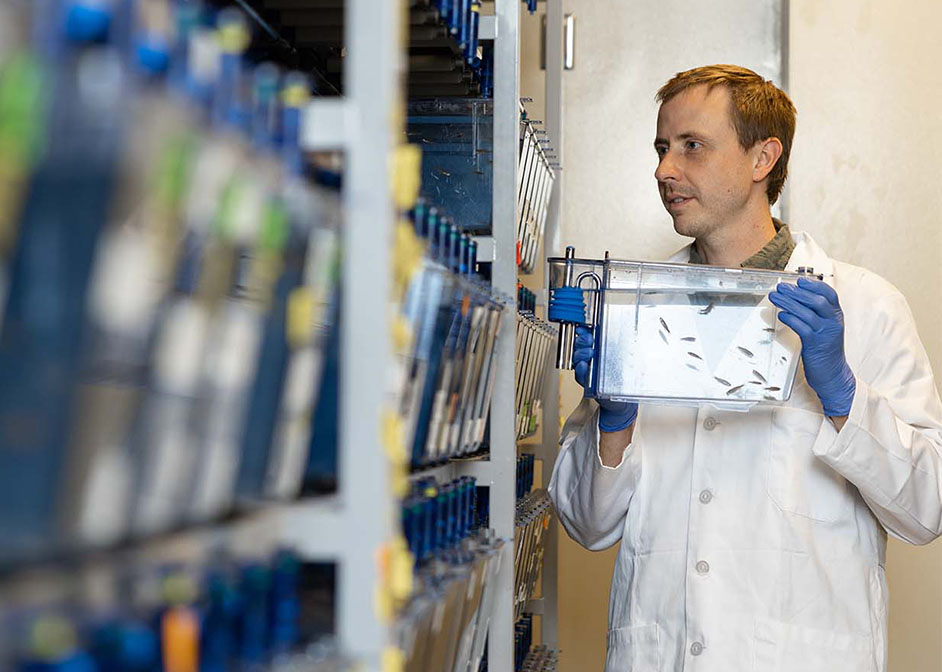UH Researcher Leads $1.9M Project That Could Lead to Better Understanding of Trait Evolution and Human Diseases
University of Houston Assistant Professor of Biology and Biochemistry Jacob Daane is leading a research project to uncover the genetic mechanisms that underlie trait evolution and disease resilience in fishes. The $1.9 million award from the National Institute of General Medical Sciences spans five years and will delve into genomic and macroevolutionary trends that precede and follow the development of specific traits in fish species that thrive in the challenging environments.

Many fish species have evolved traits that are highly adaptive in specific environments but would be considered pathological, or caused by disease, in humans. These traits include the loss of red blood cells (anemia), low skeletal density (osteopenia), accumulation of lipids (metabolic disease), loss of the glomerulus (kidney disease) and the enlargement of the heart (cardiomegaly). Daane’s laboratory seeks to know how the traits evolved and how the fishes overcame the detrimental effects of such phenotypic extremes.
“We will compare different genomes of fish species to see if there are any interesting differences that would correlate to a trait pattern,” said Daane, a faculty member at UH’s College of Natural Sciences and Mathematics. “When we find something noteworthy, we will test our candidate genes in zebrafish to see whether the gene is involved with the fish’s extreme traits.”
The project will focus on two research areas: identification of genetic mechanisms and studying the molecular mechanisms of tissue plasticity or adaptability to changes in environment. The first research area will include the impact of protein coding and gene regulatory variants, patterns of variation across a genome and the influence of specific events in the fish’s evolutionary history on their genetic outcomes.

Daane describes the second research area as more contemporary. “There’s another phenomenon in biology which is that a lot of traits are environment dependent,” he said. “The kidney is an interesting organ to study for comparative biology, evolution and environmental interaction, because in fishes, there’s a lot of variation in kidney structure, depending on their environment.”
For example, Antarctic fishes do not have glomeruli in their kidneys, which are a cluster of capillaries at the end of a kidney tubule that help filter waste products from the blood. Typically, the glomerulus would filter an “anti-freeze” protein out of the blood of cod, who need it to function properly in the freezing waters of the south pole. To aid in their survival, Antarctic fish kidneys develop without a glomerulus.
Conversely, Arctic cods in the northern hemisphere have a functioning glomerulus in the summer, but it stops working in the winter, and rejuvenates again when the waters become warmer.
Daane’s group will study how tissues adapt to changing environmental conditions by using single cell sequencing within the kidneys to identify differences in gene expression.
“We will compare one environment to another to see what genes are involved in shutting down and rejuvenation,” he said. “There's potential that study on the rejuvenation of the glomerulus in fish could lead to inspired treatments for rejuvenating damaged glomerular cells that don’t repair or regenerate in humans.”
Daane and his team will use three core methodologies: comparative genomics, zebrafish gene editing and comparative functional omics, which includes comparative single cell sequencing and comparative bulk RNA sequencing.
Comparative genomics sequences the genomes of different species with certain traits to identify regions with specific genetic signatures. That information is then used to identify regions of genomes that might be evolving in peculiar ways. The RNA sequencing measures the amount of RNA present in the cells of different species’ organs and tissues. For example, taking a closer look at the kidneys in one species and the kidney in another species, to identify gene expression.
“An interesting implication of this work is that it has the potential to inform our basic understanding of trait evolution,” Daane said.
It also has the potential, years from now, to create treatments for humans suffering from a variety of diseases. The traits Daane’s team are studying – red blood cells, bone density, fat content and kidney function – have a connection to human disease.
“These fish are remarkable in that they are evolutionary mutant models,” Daane adds. “The hope is that by learning how they overcome detrimental effects of their phenotypic extremes, we might be able to inspire new treatment avenues for overcoming disease when humans have similar phenotypes.”
Research reported in this publication was supported by the National Institute of General Medical Sciences of the National Institutes of Health under award number R35GM150590. The content is solely the responsibility of the authors and does not necessarily represent the official views of the National Institutes of Health.
- Rebeca Hawley, University Media Relations